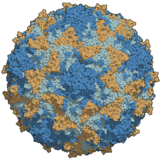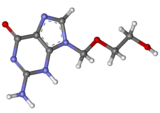
Back بوابة:علم الفيروسات Arabic درگاه:ویروس Persian Portail:Virologie French Portal:Virus ID Portal:Vírus Portuguese ද්වාරය:වෛරස Singhalese باب:وائرسز Urdu Portal:病毒 Chinese
The Viruses Portal
Welcome!

Viruses are small infectious agents that can replicate only inside the living cells of an organism. Viruses infect all forms of life, including animals, plants, fungi, bacteria and archaea. They are found in almost every ecosystem on Earth and are the most abundant type of biological entity, with millions of different types, although only about 6,000 viruses have been described in detail. Some viruses cause disease in humans, and others are responsible for economically important diseases of livestock and crops.
Virus particles (known as virions) consist of genetic material, which can be either DNA or RNA, wrapped in a protein coat called the capsid; some viruses also have an outer lipid envelope. The capsid can take simple helical or icosahedral forms, or more complex structures. The average virus is about 1/100 the size of the average bacterium, and most are too small to be seen directly with an optical microscope.
The origins of viruses are unclear: some may have evolved from plasmids, others from bacteria. Viruses are sometimes considered to be a life form, because they carry genetic material, reproduce and evolve through natural selection. However they lack key characteristics (such as cell structure) that are generally considered necessary to count as life. Because they possess some but not all such qualities, viruses have been described as "organisms at the edge of life".
Selected disease
Shingles, or herpes zoster, is a painful skin rash with blisters that, characteristically, occurs in a stripe limited to just one side of the body. The rash usually heals within 2–5 weeks, but around one in five people experience residual nerve pain for months or years.
Shingles is caused by varicella zoster virus (VZV), an alpha-herpesvirus. Initial VZV infection usually occurs in childhood causing chickenpox. After this resolves, the virus is not eliminated from the body, but remains latent in the nerve cell bodies of the dorsal root or trigeminal ganglia, without causing symptoms. Years or decades later, shingles occurs when virions in a single ganglion reactivate, travel down nerve fibres and infect the skin around the nerve. The shingles rash is restricted to the area of skin supplied by a single spinal nerve, termed the dermatome. Exactly how VZV remains latent in the body, and subsequently reactivates, is unclear.
Around a third of the population will develop shingles. Repeated episodes are rare. In the United States, about half the cases occur in people aged 50 years or older. Vaccination at least halves the risk, and prompt treatment with aciclovir or related antiviral drugs can reduce the severity and duration of the rash.
Selected image
The first immortal human cell line, HeLa cells were derived from a cervical cancer biopsy and carry human papillomavirus 18 DNA. The cells have been growing since 1951.
Credit: Gerry Shaw (8 March 2012)
In the news
26 February: In the ongoing pandemic of severe acute respiratory syndrome coronavirus 2 (SARS-CoV-2), more than 110 million confirmed cases, including 2.5 million deaths, have been documented globally since the outbreak began in December 2019. WHO
18 February: Seven asymptomatic cases of avian influenza A subtype H5N8, the first documented H5N8 cases in humans, are reported in Astrakhan Oblast, Russia, after more than 100,0000 hens died on a poultry farm in December. WHO
14 February: Seven cases of Ebola virus disease are reported in Gouécké, south-east Guinea. WHO
7 February: A case of Ebola virus disease is detected in North Kivu Province of the Democratic Republic of the Congo. WHO
4 February: An outbreak of Rift Valley fever is ongoing in Kenya, with 32 human cases, including 11 deaths, since the outbreak started in November. WHO
21 November: The US Food and Drug Administration (FDA) gives emergency-use authorisation to casirivimab/imdevimab, a combination monoclonal antibody (mAb) therapy for non-hospitalised people twelve years and over with mild-to-moderate COVID-19, after granting emergency-use authorisation to the single mAb bamlanivimab earlier in the month. FDA 1, 2
18 November: The outbreak of Ebola virus disease in Équateur Province, Democratic Republic of the Congo, which started in June, has been declared over; a total of 130 cases were recorded, with 55 deaths. UN
Selected article
The Hershey–Chase experiments were conducted by Alfred Hershey and Martha Chase in 1952 using the T2 bacteriophage (pictured), which is composed of DNA wrapped in a protein shell. Hershey and Chase labelled either the phage DNA using radioactive phosphorus-32 or the protein using radioactive sulphur-35. They allowed the radiolabelled phages to infect unlabelled bacteria, and then agitated in a blender and centrifuged to separate material remaining outside the bacterial cells. The majority of the 32P-labelled DNA entered the host bacterial cell, while all the 35S-labelled protein remained outside. Hershey and Chase also showed that the phage DNA is inserted into the bacteria shortly after the virus attaches to its host.
DNA had been known since 1869, but in 1952 many scientists believed that proteins carried the information for inheritance. Proteins appeared more complex, while DNA was thought to be an inert molecule used for phosphorus storage. These experiments built on earlier research on transformation in bacteria and helped to confirm that DNA, not protein, was the genetic material. Hershey shared the 1969 Nobel Prize in Physiology or Medicine for the research.
Selected outbreak
The 2009 flu pandemic was an influenza pandemic first recognised in Mexico City in March 2009 and declared over in August 2010. It involved a novel strain of H1N1 influenza virus with genes from five different viruses, which resulted when a previous triple reassortment of avian, swine and human influenza viruses further combined with a Eurasian swine influenza virus, leading to the term "swine flu" being used for the pandemic. It was the second pandemic to involve an H1N1 strain, the first being the 1918 "Spanish flu" pandemic.
The global infection rate was estimated as 11–21%. This pandemic strain was less lethal than previous ones, killing about 0.01–0.03% of those infected, compared with 2–3% for Spanish flu. Most experts agree that at least 284,500 people died, mainly in Africa and Southeast Asia – comparable with the normal seasonal influenza fatalities of 290,000–650,000 – leading to claims that the World Health Organization had exaggerated the danger.
Selected quotation
| “ | A virus is not an individual organism in the ordinary sense of the term, but something which could almost be called a stream of biological patterns. | ” |
Recommended articles
Viruses & Subviral agents: bat virome • elephant endotheliotropic herpesvirus • HIV • introduction to viruses![]() • Playa de Oro virus • poliovirus • prion • rotavirus
• Playa de Oro virus • poliovirus • prion • rotavirus![]() • virus
• virus![]()
Diseases: colony collapse disorder • common cold • croup • dengue fever![]() • gastroenteritis • Guillain–Barré syndrome • hepatitis B • hepatitis C • hepatitis E • herpes simplex • HIV/AIDS • influenza
• gastroenteritis • Guillain–Barré syndrome • hepatitis B • hepatitis C • hepatitis E • herpes simplex • HIV/AIDS • influenza![]() • meningitis
• meningitis![]() • myxomatosis • polio
• myxomatosis • polio![]() • pneumonia • shingles • smallpox
• pneumonia • shingles • smallpox
Epidemiology & Interventions: 2007 Bernard Matthews H5N1 outbreak • Coalition for Epidemic Preparedness Innovations • Disease X • 2009 flu pandemic • HIV/AIDS in Malawi • polio vaccine • Spanish flu • West African Ebola virus epidemic
Virus–Host interactions: antibody • host • immune system![]() • parasitism • RNA interference
• parasitism • RNA interference![]()
Methodology: metagenomics
Social & Media: And the Band Played On • Contagion • "Flu Season" • Frank's Cock![]() • Race Against Time: Searching for Hope in AIDS-Ravaged Africa
• Race Against Time: Searching for Hope in AIDS-Ravaged Africa![]() • social history of viruses
• social history of viruses![]() • "Steve Burdick" • "The Time Is Now" • "What Lies Below"
• "Steve Burdick" • "The Time Is Now" • "What Lies Below"
People: Brownie Mary • Macfarlane Burnet![]() • Bobbi Campbell • Aniru Conteh • people with hepatitis C
• Bobbi Campbell • Aniru Conteh • people with hepatitis C![]() • HIV-positive people
• HIV-positive people![]() • Bette Korber • Henrietta Lacks • Linda Laubenstein • Barbara McClintock
• Bette Korber • Henrietta Lacks • Linda Laubenstein • Barbara McClintock![]() • poliomyelitis survivors
• poliomyelitis survivors![]() • Joseph Sonnabend • Eli Todd • Ryan White
• Joseph Sonnabend • Eli Todd • Ryan White![]()
Selected virus
Poliovirus is an enterovirus, an RNA virus in the Picornaviridae family, associated with the paralytic disease polio. The icosahedral virus particle is about 30 nanometres in diameter and lacks an envelope. It contains a relatively short, single-stranded positive RNA genome of around 7500 nucleotides, which encodes about ten viral products. The virus has a fairly high mutation rate even for an RNA virus. Historically there were three serotypes, each with a slightly different capsid protein; PV1 is the most common, and PV2 was declared eradicated in 2015.
The virus only naturally infects humans, although some monkeys can be infected experimentally; 95% of infections are asymptomatic. Infection occurs via the faecal–oral route and viral replication occurs in the alimentary tract. The virus enters the host cell by binding to an immunoglobulin-like receptor, CD155. Fully assembled poliovirus leaves the cell 4–6 hours after initiation of infection. Poliovirus was first isolated in 1909 by Karl Landsteiner and Erwin Popper. Its genome was sequenced in 1981. Among the simplest clinically significant viruses, poliovirus is one of the best-characterised viruses, and has become a useful model for studying RNA viruses.
Did you know?
- ...that elephant endotheliotropic herpesvirus, found mostly among young captive Asian elephants (pictured), can have a fatality rate of up to 90%?
- ...that epidemiologist Joseph L. Melnick found that polio chiefly spread through fecal contamination, usually by soiled hands, and that the poliovirus could survive for extended periods in sewage?
- ...that a global advisory committee has been monitoring rapidly developing COVID-19 vaccines against a background of growing misinformation and vaccine hesitancy?
- ...that sexual-health doctor Mags Portman and activist Greg Owen worked together to provide accessible HIV medication, preventing thousands of new HIV diagnoses in the United Kingdom?
- ...that before the Hershey–Chase experiment confirmed the role of DNA, scientists believed that genes were carried by proteins?
Selected biography
Randy Shilts (8 August 1951 – 17 February 1994) was an American journalist, author and AIDS activist. The first openly gay reporter for a mainstream US newspaper, Shilts covered the unfolding story of AIDS and its medical, social, and political ramifications from the first reports of the disease in 1981. New York University's journalism department later ranked his 1981–85 AIDS reporting in the top fifty works of American journalism of the 20th century. His extensively researched account of the early days of the epidemic in the US, And the Band Played On Politics, People, and the AIDS Epidemic, first published in 1987, brought him national fame. The book won the Stonewall Book Award and was made into an award-winning film. Shilts saw himself as a literary journalist in the tradition of Truman Capote and Norman Mailer. His writing has a powerful narrative drive and interweaves personal stories with political and social reporting.
He received the 1988 Outstanding Author award from the American Society of Journalists and Authors, the 1990 Mather Lectureship at Harvard University, and the 1993 Lifetime Achievement Award from the National Lesbian and Gay Journalists' Association. He died of AIDS in 1994.
In this month
1 August 1971: The term viroid was coined by Theodor Diener to describe the agent of potato spindle tuber disease
6 August 2007: Maraviroc, first CCR5 receptor antagonist, approved for HIV/AIDS
8 August 2011: UN declared rinderpest eradicated
8 August 2014: WHO declared the Ebola outbreak in West Africa (virus pictured), the most widespread so far, an international public health emergency
18 August 1990: Ryan White Care Act enacted, the largest American federally funded programme for people living with HIV/AIDS
20 August 1780: Start of an outbreak of dengue fever in Philadelphia, USA, which led Benjamin Rush to describe the disease in 1789
26 August 1976: First case of Ebola virus, now the Zaire form
26 August 1998: Fomivirsen, first antisense drug, approved for cytomegalovirus retinitis
Selected intervention
Aciclovir (also acyclovir and sold as Zovirax) is a nucleoside analogue that mimics the nucleoside guanosine. It is active against most viruses in the herpesvirus family, and is mainly used to treat herpes simplex virus infections, chickenpox and shingles. After phosphorylation by viral thymidine kinase and cellular enzymes, the drug inhibits the viral DNA polymerase. Extremely selective and low in cytotoxicity, it was seen as the start of a new era in antiviral therapy. Aciclovir was discovered by Howard Schaeffer and colleagues, and developed by Schaeffer and Gertrude Elion, who was awarded the 1988 Nobel Prize in Medicine in part for its development. Nucleosides isolated from a Caribbean sponge, Cryptotethya crypta, formed the basis for its synthesis. Aciclovir differs from earlier nucleoside analogues in containing only a partial nucleoside structure: the sugar ring is replaced with an open chain. Resistance to the drug is rare in people with a normal immune system.
Subcategories
Subcategories of virology:
Topics
Things to do
- Comment on what you like and dislike about this portal
- Join the Viruses WikiProject
- Tag articles on viruses and virology with the project banner by adding {{WikiProject Viruses}} to the talk page
- Assess unassessed articles against the project standards
- Create requested pages: red-linked viruses | red-linked virus genera
- Expand a virus stub into a full article, adding images, citations, references and taxoboxes, following the project guidelines
- Create a new article (or expand an old one 5-fold) and nominate it for the main page Did You Know? section
- Improve a B-class article and nominate it for Good Article
 or Featured Article
or Featured Article status
status - Suggest articles, pictures, interesting facts, events and news to be featured here on the portal
WikiProjects & Portals
 WikiProject Viruses
Related WikiProjects
WikiProject Viruses
Related WikiProjects
Medicine • Microbiology • Molecular & Cellular Biology • Veterinary Medicine
Related PortalsAssociated Wikimedia
The following Wikimedia Foundation sister projects provide more on this subject:
-
Commons
Free media repository -
Wikibooks
Free textbooks and manuals -
Wikidata
Free knowledge base -
Wikinews
Free-content news -
Wikiquote
Collection of quotations -
Wikisource
Free-content library -
Wikispecies
Directory of species -
Wikiversity
Free learning tools -
Wiktionary
Dictionary and thesaurus

















